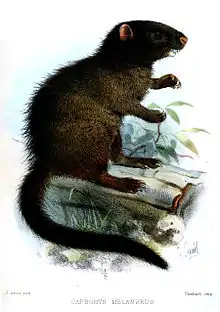Black-tailed hutia
The black-tailed hutia (Mesocapromys melanurus), also known as the bushy-tailed hutia, is a small, furry, rat-like mammal found only in Cuba. It lives in lowland moist forests and is threatened by habitat loss.[2] It is a member of the hutia subfamily (Capromyinae), a group of rodents native to the Caribbean that are mostly endangered or extinct.
| Black-tailed hutia | |
|---|---|
 | |
| Scientific classification | |
| Domain: | Eukaryota |
| Kingdom: | Animalia |
| Phylum: | Chordata |
| Class: | Mammalia |
| Order: | Rodentia |
| Family: | Echimyidae |
| Tribe: | Capromyini |
| Genus: | Mesocapromys |
| Species: | M. melanurus |
| Binomial name | |
| Mesocapromys melanurus (Poey, 1865) | |
| Synonyms | |
| |
Although it was formerly classified in the genus Mysateles, phylogenetic evidence supports it belonging to the genus Mesocapromys.[3]
References
- Kennerley, R.; Young, R.; Turvey, S.T.; Borotto-Páez, R. (2018). "Mysateles melanurus". IUCN Red List of Threatened Species. 2018: e.T14256A22187606. doi:10.2305/IUCN.UK.2018-1.RLTS.T14256A22187606.en. Retrieved 11 November 2022.
- "Explore the Database". www.mammaldiversity.org. Retrieved 2021-10-02.
- Fabre, Pierre-Henri; Upham, Nathan S.; Emmons, Louise H.; Justy, Fabienne; Leite, Yuri L. R.; Loss, Ana Carolina; Orlando, Ludovic; Tilak, Marie-Ka; Patterson, Bruce D.; Douzery, Emmanuel J. P. (2016-12-25). "Mitogenomic phylogeny, diversification, and biogeography of South American spiny rats". Molecular Biology and Evolution: msw261. doi:10.1093/molbev/msw261. ISSN 0737-4038.
- Woods, C.A.; Kilpatrick, C.W. (2005). "Infraorder Hystricognathi". In Wilson, D.E.; Reeder, D.M (eds.). Mammal Species of the World: A Taxonomic and Geographic Reference (3rd ed.). Johns Hopkins University Press. pp. 1538–1600. ISBN 978-0-8018-8221-0. OCLC 62265494.
This article is issued from Wikipedia. The text is licensed under Creative Commons - Attribution - Sharealike. Additional terms may apply for the media files.
